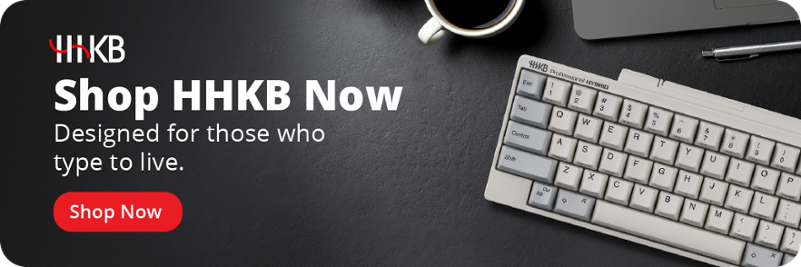Why wrist (and palm) support is an essential consideration for every typist
If you’ve been typing for very long, you’ve likely heard some of the debates about keyboard wrist support. Some say wrist supports contribute to poor typing form and can do more harm than good, while others say they’re generally a good idea.
Ultimately, much of the debate surrounding keyboard wrist rest ergonomics may stem from misunderstanding the name itself. Regardless, it all reflects an important element that every typist should consider for their setup.
Find more ways to improve your typing experience in our guide, How to Find the Best Keyboard for Typing.
Jump to a section:
What is keyboard wrist support?
A keyboard wrist support is any accessory or posture that allows a keyboard user’s wrists to lay on a designated spot as they type or rest their hands. This is often achieved through wrist rests: some are hard molded plastic, some have a fabric shell over a pliable gel interior, some come attached to a keyboard, and others are sold separately.
The confusing part is that, while you’re typing, your wrists generally shouldn’t rest on anything at all. Pressing the underside of your wrist against a rest as you type can actually put more pressure on your carpal tunnel, increasing the risk of short-term issues such as discomfort, numbness, or tingling, as well as longer-term problems such as repetitive strain injuries.
So why are wrist rests sold at all? Well, it can be helpful to have a spot to rest your wrists when you’re at the computer but aren’t actively typing. This is especially true if you might otherwise tend to lay your wrists on a hard or angular surface, such as the edge of a desk or counter.
More broadly, when people talk about keyboard wrist support, they often actually mean palm, or palm heel, support. The heel of the palm is generally tough and bony, meaning it can be as susceptible to problems stemming from external pressure. A palm rest can help keep its user’s wrists in a comfortably neutral angle as their hands “float” over the board and their fingers move up and down. This encourages a healthy range of motion rather than restricting it.
Whether targeting the wrist, palm, or any other part of the body, experts agree that encouraging a comfortably neutral position should be the ultimate goal of any ergonomic keyboard setup.
Did You Know?:HHKB Studio was created to allow for minimal movement and endless creativity. Click here to learn more.
Why keyboard wrist rest ergonomics are essential
We’ve cut through some of the confusion surrounding keyboard wrist support and palm support. Now let’s lay out why, whether you decide to use dedicated accessories or not, it can be a rewarding aspect to prioritize for effective keyboard setups.
- They can help prevent repetitive strain injuries A 2023 publication by the CDC found that 9% of U.S. adult participants in a 2021 study developed a repetitive strain injury (RSI) within its three-month survey window. Typing was one of the leading causes cited for such injuries. While no single “magic bullet” can eliminate the risk of RSIs among frequent typists, the thoughtful use of wrist and palm rests and other postural aids can play an important role in delaying or lessening their impact.
- They may be legally mandated You may picture protective railings and cautionary signs around dangerous equipment when you think of OSHA. However, federal law entitles all OSHA workers — not just those in heavy industry — to safe workplaces. If you run a business where employees spend a significant amount of time at computer workstations, you’re responsible for taking reasonable precautions against RSIs. Keyboard wrist rest ergonomics are one important factor to weigh.
- They make work and play more comfortable Sometimes, a little discomfort can be a good thing — it can be a sign of growth. But assuming you’re already a proficient typist, that should not be the case for your time at the keyboard. Even if you aren’t worried about the prospect of RSIs, enhancing the comfort of this everyday activity will make it easier to get your work done, enjoy creative pursuits, and relax with games or other activities.
- They’re a great way to personalize your setup Modern computer users enjoy nigh-endless ways to customize their typing experience: Keyboard layouts, keycaps, and mechanical keyboard switches can all be swapped and tweaked to suit individual preferences. Adding a wrist or palm rest to your setup gives you another chance to choose your favorite shape, material, and even color. The tough part is deciding whether to go for a matching aesthetic or opt for a bold, contrasting look.
- They can be the first step toward better ergonomics overall For many computer users, keyboard wrist support may be the first thing they think of when they hear “ergonomics.” Considering your wrist health is an integral part of creating a more comfortable and better setup for work, play, and creation. But think of wrist and palm rests as a gateway, not the destination. Your desk, chair, monitor, and keyboard are all equally important parts of an ergonomic setup.
Did You Know?:Our HHKB Studio look book is full of inspiration for your next creative environment. Click here to learn more.
A few changes here and there can go a long way toward a lifetime of healthy, productive, and fun computer use.
Types of keyboard wrist support
Comfort is such a personal experience, especially while typing. Luckily, there are a variety of keyboard wrist support options available to meet your specific needs. The following are some of the most common supports available.
- Plastic rests are inexpensive, solid bars that provide the necessary angle of support for your wrists and palms without any extra bells and whistles.
- Wood blocks are similar to plastic rests. They’re tough and don’t have much give when it comes to supporting your hands while you type. However, their choice of hardwoods like beech, maple, or walnut are much more stylish and likely to last over a longer period than plastic.
- Foam pads offer more comfort than wood or plastic supports. They often use a form of memory foam that contours to the weight of your palms, while the underside is usually a solid, rubberized base to keep the support in place on your desk.
- Beaded cushions are lightweight rests that use plastic beads to provide cushion and support. They often use covers made with a polyester/cotton-blend fabric to keep them breathable and easy to wash.
Placement and usage of keyboard wrist supports
Your keyboard wrist support is only as good as your placement. Proper usage can improve how well your support works to improve wrist comfort and reduce strain.
According to OSHA, your wrist or palm rests “should be part of an ergonomically-coordinated computer workstation.” Your desk, chair, and keyboard should all be properly aligned so your supports help you maintain an “in-line, neutral posture.” The keyboard wrist rest should match the footprint and slope of the front edge of your keyboard so it keeps your wrists straight while you type. OSHA recommends supports that are soft and rounded to reduce pressure, and they should be at least 1.5 inches deep to provide ample space.
Signs you may need keyboard wrist support
A keyboard wrist support can be a helpful aid for workers who need to type frequently, but they’re not always necessary. The following are a few signs that may tell you whether you should add a support to your workstation.
- You feel wrist pain while typing: Pain in your wrists is your brain telling your body that something is wrong with your current keyboard setup. At the very least, you should investigate why you’re experiencing pain and adjust your workspace to alleviate it. A keyboard wrist support may help in reducing this pain.
- You’re unable to maintain a neutral typing position: Depending on your current setup, you may not be able to configure your desk, chair, or keyboard in such a way that your wrists rest in a neutral position. In this case, a support may help fix that for you.
- The edge of your desk is too sharp: If your desk is digging into your palms or wrist while you type, a cushioned support may help to keep you comfortable.
What to avoid when using a keyboard wrist support
If you decide to pick up a wrist support, remember that maintaining a neutral position is the most important part of comfortable typing. Any wrist rest that’s too tall, too short, or doesn’t line up well with your keyboard may cause more harm than good.
Additionally, consider supports made out of materials that won’t stain or absorb your skin’s natural oils. Some rests use leatherette covers that may look nice, but aren’t as breathable or easy to clean as cloth-based covers. Meanwhile, wood wrist rests may lack the cushion found in foam or beaded supports, but are quick and easy to clean in just a few minutes.
Get a comfortable and great-looking wrist rest
One of the best changes you can make right now? Adopt a keyboard layout that was created to be both more comfortable and productive. The HHKB layout was built with those goals in mind, making several easy-to-learn yet impactful changes to the standard QWERTY layout to encourage fast typing with less strain on the wrists and fingers.
There’s no better place to start typing HHKB than on an HHKB Professional board — and for custom-made wrist support as you make the switch, try the official Happy Hacking Keyboard wood wrist rest. These official accessories are made of beech and maple hardwood for long-lasting support and come in four elegant finishes.
Find the ideal addition to your ergonomic computer setup with a new high-end keyboard from HHKB.
Note: Information and external links are provided for your convenience and for educational purposes only and shall not be construed, or relied upon, as medical advice, treatment, or diagnosis. PFU America, Inc. makes no representations about the contents, features, or specifications on such third-party sites, software, and/or offerings (collectively “Third-Party Offerings”) and shall not be responsible for any loss or damage that may arise from your use of such Third-Party Offerings. Please consult a licensed professional regarding your specific health needs.





